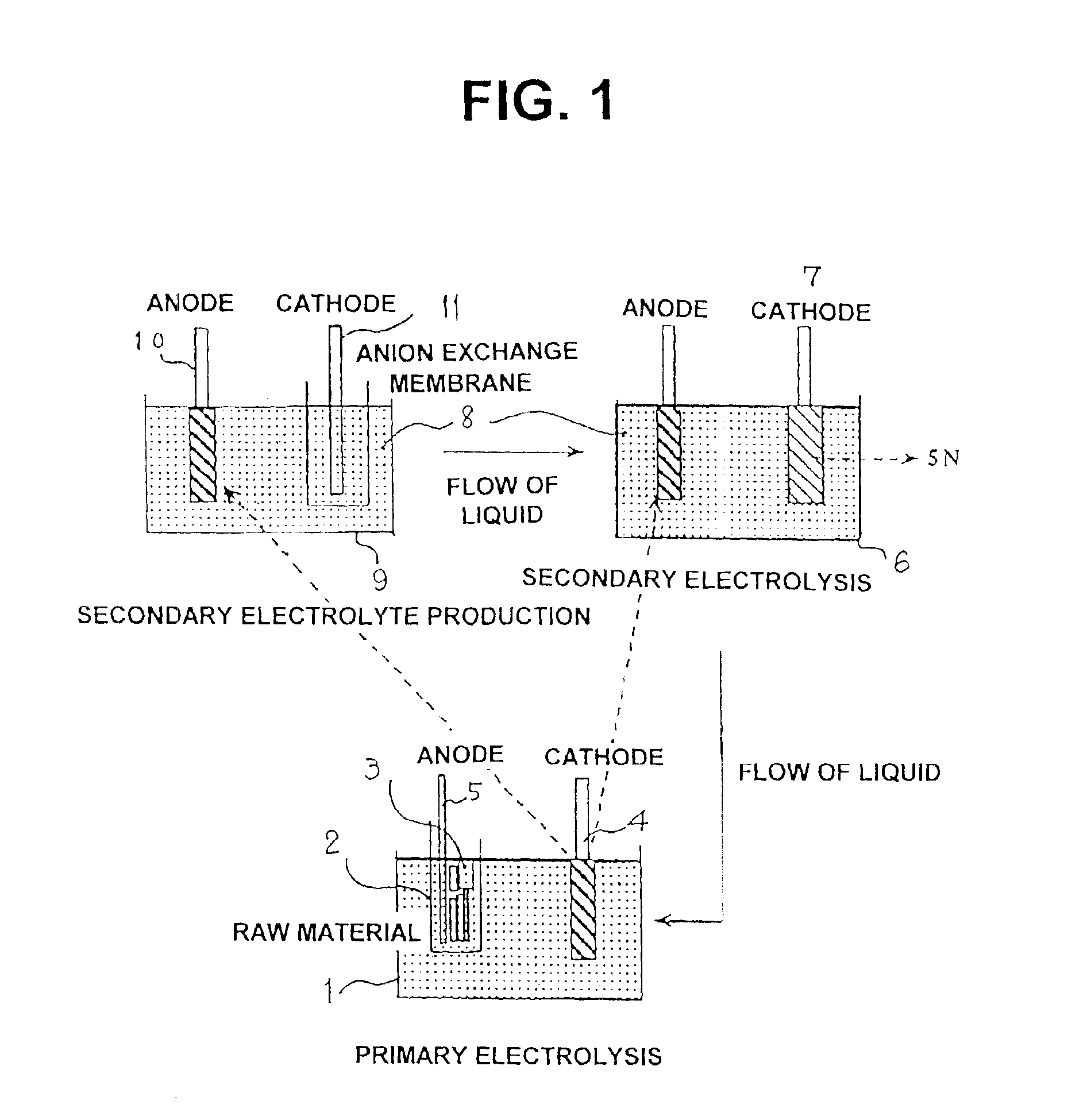Method of producing a higher-purity metal
- Summary
- Abstract
- Description
- Claims
- Application Information
AI Technical Summary
Benefits of technology
Problems solved by technology
Method used
Image
Examples
example 1
[0035]An electrolytic tank as shown in FIG. 1 was used to perform electrolysis with a 3N level massive iron as the anode, and a 4N level iron as the cathode.
[0036]Electrolysis was implemented with a bath temperature of 50° C., hydrochloric electrolytic solution at pH2, iron concentration of 50 g / L, and current density of 1A / dm2. Obtained thereby was electrolytic iron (deposited to the cathode) having a current efficiency of 90% and a purity level of 4N.
[0037]Next, this electrolytic iron was dissolved with a mixed solution of hydrochloric acid and hydrogen peroxide solution, and made into an electrolytic solution for secondary electrolysis by adjusting pH with ammonia. Further, a second electrolysis (secondary electrolysis) was implemented with the 4N level primary electrolytic iron deposited to the foregoing cathode as the anode.
[0038]Conditions for the electrolysis are the same as those for the primary electrolysis. Electrolysis was implemented with a bath temperature of 50° C., hy...
example 2
[0042]Similar to aforementioned Example 1, an electrolytic tank as shown in FIG. 1 was used to perform electrolysis with a 3N level massive cadmium as the anode, and titanium as the cathode.
[0043]Electrolysis was implemented with a bath temperature of 30° C., sulfuric acid of 80 g / L, cadmium concentration of 70 g / L, and current density of 1A / dm2. Obtained thereby was electrolytic cadmium (deposited to the cathode) having a current efficiency of 85% and a purity level of 4N.
[0044]Next, this electrolytic cadmium was electrolyzed with a sulfate bath, and made into an electrolytic solution for secondary electrolysis. Further, a second electrolysis (secondary electrolysis) was implemented with the 4N level primary electrolytic cadmium deposited to the foregoing cathode as the anode.
[0045]Conditions for the electrolysis are the same as those for the primary electrolysis. Electrolysis was implemented with a bath temperature of 30° C., sulfuric acid of 80 g / L, cadmium concentration of 70 g / ...
example 3
[0050]Similar to aforementioned Example 1, an electrolytic tank as shown in FIG. 1 was used to perform electrolysis with a 3N level massive cobalt as the anode, and a 4N level cobalt as the cathode.
[0051]Electrolysis was implemented with a bath temperature of 40° C., hydrochloric electrolytic solution at pH2, cobalt concentration of 100 g / L, current density of 1A / dm2, and an electrolyzing time of 40 hours. Obtained thereby was approximately 1 kg of electrolytic cobalt (deposited to the cathode) having a current efficiency of 90%. The purity level thereof was 4N.
[0052]Next, this electrolytic cobalt was dissolved with sulfuric acid, and made into an electrolytic solution for secondary electrolysis by adjusting to pH with ammonia. Further, a second electrolysis (secondary electrolysis) was implemented with the 4N level primary electrolytic cobalt deposited to the foregoing cathode as the anode.
[0053]Conditions for the electrolysis are the same as those for the primary electrolysis, and...
PUM
| Property | Measurement | Unit |
|---|---|---|
| Fraction | aaaaa | aaaaa |
| Fraction | aaaaa | aaaaa |
| Force | aaaaa | aaaaa |
Abstract
Description
Claims
Application Information
 Login to View More
Login to View More - R&D
- Intellectual Property
- Life Sciences
- Materials
- Tech Scout
- Unparalleled Data Quality
- Higher Quality Content
- 60% Fewer Hallucinations
Browse by: Latest US Patents, China's latest patents, Technical Efficacy Thesaurus, Application Domain, Technology Topic, Popular Technical Reports.
© 2025 PatSnap. All rights reserved.Legal|Privacy policy|Modern Slavery Act Transparency Statement|Sitemap|About US| Contact US: help@patsnap.com


